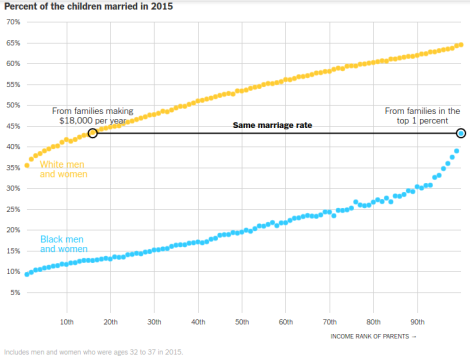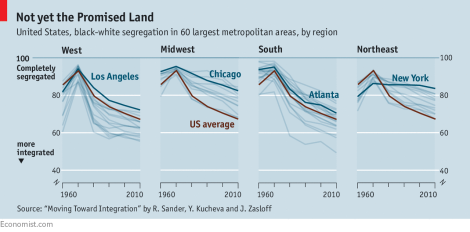Sources: The Economist, 7 April 2018; New York Times, 19 March 2018; Market Watch, 5 May 2018
Links: 50 Years After MLK’s Death: A divided America; Extensive Data Shows Punishing Reach of Racism for Black Boys; How “redlining” still hurts home values
Summary: The economic disparities between African- and white Americans are still significant. Progress has been made in some ways, but the country is still quite segregated, the same equality of opportunity does not exist for the two groups, and consequences of past racist policies are long-lasting.
Statistics:
- In 1970, on a scale of 1-100, segregation in American cities was at 93. Today, it has dropped to 70. Segregation is lower in the West and South, higher in the Northest and Midwest.
- In 2000, 7 million Americans lived in areas of concentrated poverty. Today, that number has doubled, to 14 million. Only 8% of poor whites live in these areas with more than 40% below the poverty level, but 25% of poor African-Americans do, and 17% of poor Hispanics.
- “Between 1991 and 2012, segregation of poor pupils increased by 40%. Research by Sean Reardon of Stanford University shows that the gap in achievement between rich and poor pupils is now twice as large as that between black and white ones.”
- “The Moving to Opportunity Scheme, sponsored by HUD, randomly assigned families to receive housing vouchers that required them to move to better areas. The benefits were, in social-science terms, astonishing. Children who moved before the age of 13 went on to have incomes 31% higher than those who remained.”
- “Redlining” was a practice that started in the 1930s, labeling certain neighborhoods, mostly African-American ones, as too risky for banks to make mortgage loans to. Redlining was outlawed in 1968, but still, 50 years later, “a home located in an area that was given a “hazardous” rating… is only worth 85% of the median value of a home in surrounding, non-redlined neighborhoods.”
- In some cities, this effect is not seen. Boston, Minneapolis, Philadelphia, and Portland’s old “redlined” neighborhoods actually have higher values today than the non-redlined ones. On the other hand, in places like Atlanta or Tampa, formerly redlined areas’ values are less than half those around them.
- “To this day, the homeownership rate among white people is significant higher than it is for other races, according to data from the U.S. Census Bureau. As of the fourth quarter of 2017, 72.7% of non-Hispanic white households were homeowners, as compared with 42.1% of black households, 58.2% of Asian and Pacific Islander households and 46.6% of Hispanic households.
- “Homeownership is one of the main pathways to building wealth. Consequently, the lower homeownership rates within communities of color have contributed to the persistent wealth gap. Boosting the returns on homeownership for black families would reduce the wealth gap with white families by more than $17,000 or 16%”
- “The median net worth of black households with at least a bachelor’s degree was $26,300 in 2013. For households headed by white holders of college degrees, the median net worth was $301,300–11 times greater.”
A major research study was done on the 20 million children born between 1978 and 1983, examining the neighborhood and household income of the children, and comparing it to their income as adults. The remaining stats are from that study:
- “Even when children grow up next to each other with parents who earn similar incomes, black boys fare worse than white boys in 99 percent of America.”
- “According to the study, led by researchers at Stanford, Harvard and the Census Bureau, income inequality between blacks and whites is driven entirely by what is happening among these boys and the men they become.”
- “Gaps persisted even when black and white boys grew up in families with the same income, similar family structures, similar education levels and even similar levels of accumulated wealth.”
- Conversely, “black and white girls from families with comparable earnings attain similar individual incomes as adults.”
- There are very few neighborhoods in the United States where poor whites and poor blacks have adult income outcomes that are similar. The ones that do exist share the following traits: They had low poverty rates, low discrimination, and they were areas where many black fathers were present in poor households. “Poor black boys did well in such places, whether their own fathers were present or not. “They’re not talking about the direct effects of a boy’s own parents’ marital status. They’re talking about the presence of fathers in a given census tract.” “
- “The new data shows that 21 percent of black men raised at the very bottom were incarcerated, according to a snapshot of a single day during the 2010 census. Black men raised in the top 1 percent — by millionaires — were as likely to be incarcerated as white men raised in households earning about $36,000.”
- For both blacks and whites, the higher the income, the greater the rates of marriage. However, the richest 1% of blacks have a marriage rate of 44%–and 85% of white households have a higher marriage rate than that.
- All children benefited economically from growing up in a two-parent household–but white children benefited more.






